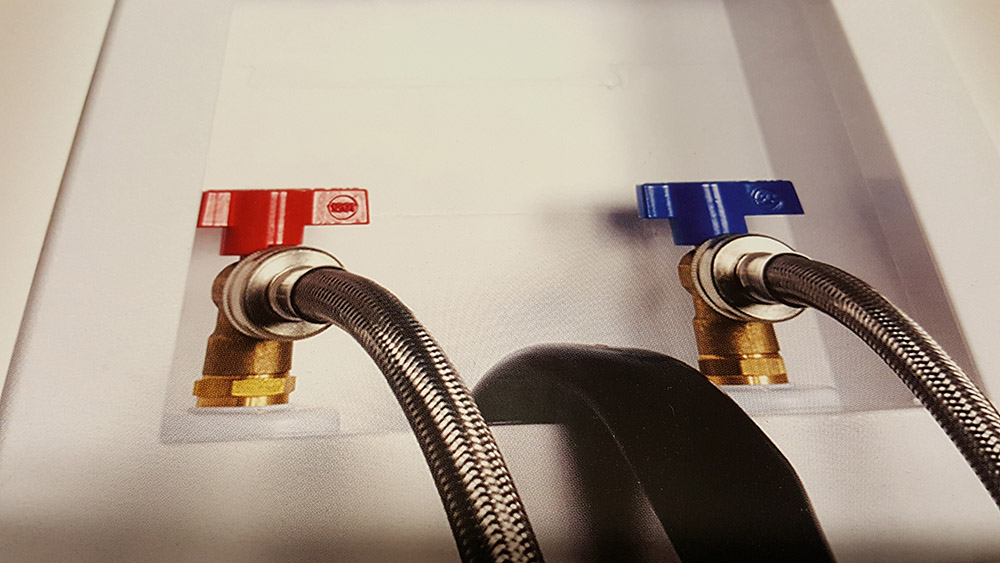4.6 Plumbing for Appliances
Appliances are a vital part of a functioning residential dwelling, and some appliances connect to plumbing systems. Some appliances require a plumber to install the piping systems during the rough-in phase of construction, while other appliances are installed by a plumber during the trim-out phase of construction.
Plumbing Connections for Appliances
APPLIANCE |
COLD WATER |
HOT WATER |
DRAIN |
| Garbage Disposal | No | No | No |
| Dishwasher | No | Yes | Yes |
| Icemaker | Yes | No | No |
| Washing Machine | Yes | Yes | Yes |
Dishwashers
A plumber normally installs a dishwasher during the trim-out phase of construction, typically at the same time as the sink and garbage disposer. A dishwasher receives hot water from the same water source that serves the kitchen sink. Many codes require that a dishwasher drain hose be routed through an air gap device to prevent wastewater from flowing from the sink into the dishwasher.
The water supply piping to a dishwasher is typically 3/8” OD tubing, with the hot water supply routed from under the kitchen sink. The drain hose from the dishwasher connects to either a dedicated connection of a garbage disposer or tailpiece. A dishwasher has leveling legs that can be adjusted to accommodate the opening height from the floor to the underside of the dishwasher.
Although dishwashers can connect to a kitchen sink drain with a special “Wye” fitting, most dishwashers discharge through garbage disposals at a designated dishwasher connection located on the side of a disposer. If a hose end is not compatible with the garbage disposer, a boot is used for the connection. A rubber dishwasher boot requires a small piece of copper to be inserted into the boot and the dishwasher hose, and then all connections are sealed with hose clamps.
Whirlpool Dishwasher Removal and Installation
Garbage Disposers
A garbage disposer is a motorized appliance that is activated manually with electrical current. It has an internal rotating flywheel to shred food waste which is discharged into the drainage system. The horsepower of the motor determines the capabilities of the garbage disposer. The most common HP sizes for residential applications range from 1/3” to 3/4”. A garbage disposer is commonly installed in a kitchen sink with a specially designed mounting assembly where a basket strainer would normally be installed. This multi-piece assembly consists of a sink flange that is inserted and sealed into the sink drain outlet where a basket strainer would normally be installed. The rubber gasket creating the seal between the disposer and the mounting assembly also serves as a noise reduction item. A garbage disposer has a designated port to accept the dishwasher drain hose.
Biodegradable products can be added to a septic tank to stimulate the decomposition of food waste within the septic tank. If a homeowner does not add the biodegradable solution, the food waste will settle to the bottom of the tank.
How to Install / Remove a Garbage Disposal – InSinkErator
Garbage Disposal Repair | How to Fix a Garbage Disposal – InSinkErator
Reset the Overload Protector on InSinkErator Garbage Disposal
Washing Machine Boxes
A washing machine box is used to provide hot water, cold water, and a drain connection in one central location. Most codes also require that the smallest size water supply that can be installed serving a washing machine is 1/2” (5/8”OD). Hose end style valves are integrated into the box’s design to provide hot and cold supply water to the washing machine. Traditional stops with rubber washers are common in residential applications, but 1/4 turn ball valve stops are becoming more commonly used by contractors and over time are more reliable. A typical residential washing machine box is manufactured to be recessed in a wall cavity with a hub to receive 2” plastic pipe because most codes dictate that the minimum size drain that can be installed serving a washing machine is 2”.

Washer Box by Clifford Rutherford is licensed under CC BY 4.0
Icemaker Boxes
A plumber routes the cold water piping to the refrigerator area and installs an icemaker box as the termination point of the potable water supply. The box is installed between two vertical wood studs and near the floor during the rough-in phase of construction. A plumber installs 1/2” pipe to the icemaker box and connects the piping to the angle valve provided with the box. The outlet of the valve that is purchased with the box has a 1/4” OD compression connection to allow the compatible tubing of the refrigerator to connect with the icemaker valve.
